(This is a re-print from my blog at gamemakeworld.wordpress.com.)
PixelJunk Monsters Online is the Facebook app version of the PixelJunk Monsters series, developed by Q-Games (Japan). It is a free-to-play "tower defense" game, and became an open beta in 2011.
WORLDVIEW: Protecting and expanding your cute, colorful kingdom.
VISUALS
The stage selection screen is presented as a collection of islands, each divided into 3-8 stages. When you complete a stage it turns from desolate brown to lively green, with various distinguishing geographic and decorative features (snowy stages follow a similar pattern, if not brown to green).
If you do "perfect" on a stage, a rainbow appears above it and you receive "Rainbow Juice," which is essentially the game's virtual currency and can be purchased with real money. You can use it to purchase items, skip long waiting times, and unlock new islands by pouring it over the island's port in a satisfying animation. Rainbow Juice works great, capturing the game's cuteness while also sounding mystical and expensive.
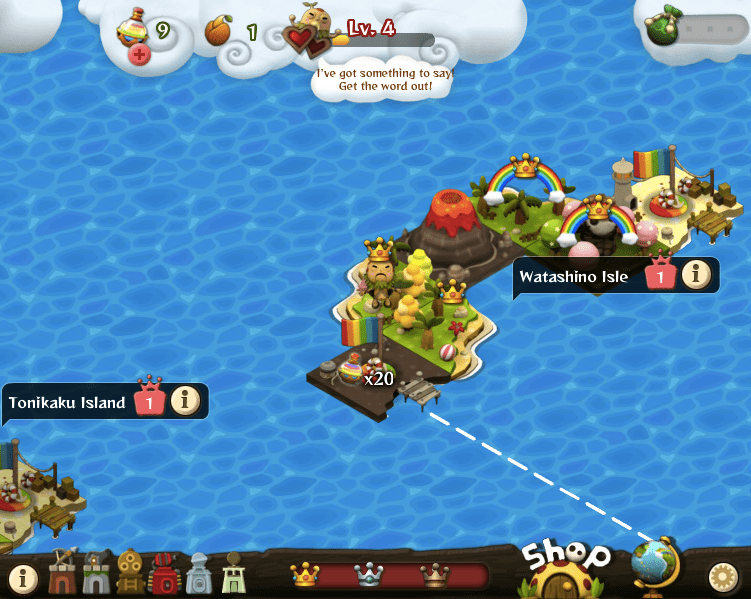
PJMO
Fig. 1 Stages have a crown over them when completed and a rainbow when "perfect"Additionally, some stages are blocked by a volcano and cannot be accessed until the adjacent areas have rainbows- then a hammer flattens the volcano into a playable level.Turning brown islands into lush green, unlocking volcano stages with rainbows and hammers, and pouring rainbow juice on island ports are all great touches that build upon the theme of a journey to transform dangerous, desolate lands into a part of your colorful kingdom.The island theme of the main map carries over to the individual stages. Each stage is a beach with a path leading to your home-base and ten "Tiki children" gathered there. You must protect them from oncoming enemies with defensive towers, which can be built wherever a tree is growing.To upgrade towers, the player character ("Tikiman") dances on them. The dancing animation itself is delightful, and the idea of making towers more powerful through dancing is fittingly cute.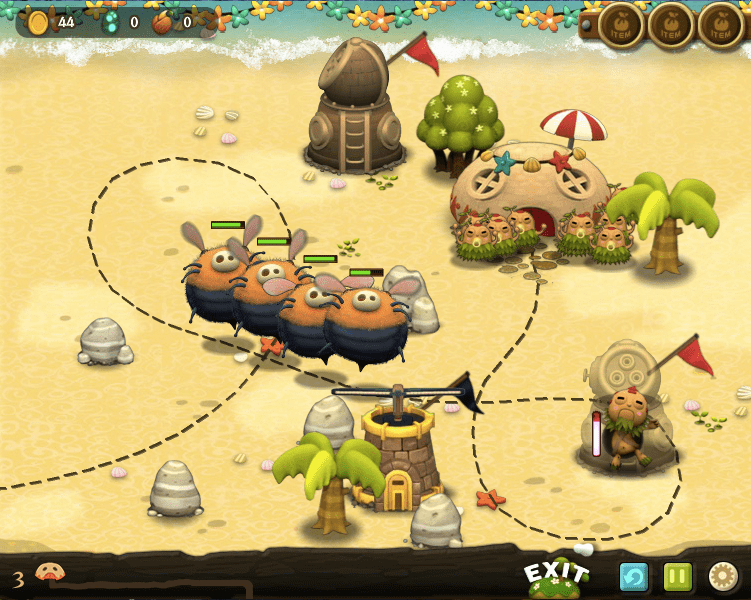 Fig. 2 Dancing on a tower makes it more powerfulThe enemies range from bats, to golems, to overweight bees, but they all wear similar white masks with two eye holes cut out. This helps unify the various designs into a cohesive army of evil, while also setting them apart from the generic spiders, bats, and such in other games.Pop-up menus prompting the player to post to their Facebook timeline are consistent with the game's style and relatively infrequent. Compare them with those of Candy Crush Saga, where the player is prompted to share up to three times between every stage, with many facebook-y intrusions (friends' pictures and names constantly appearing in pop-up windows, etc.).
Fig. 2 Dancing on a tower makes it more powerfulThe enemies range from bats, to golems, to overweight bees, but they all wear similar white masks with two eye holes cut out. This helps unify the various designs into a cohesive army of evil, while also setting them apart from the generic spiders, bats, and such in other games.Pop-up menus prompting the player to post to their Facebook timeline are consistent with the game's style and relatively infrequent. Compare them with those of Candy Crush Saga, where the player is prompted to share up to three times between every stage, with many facebook-y intrusions (friends' pictures and names constantly appearing in pop-up windows, etc.).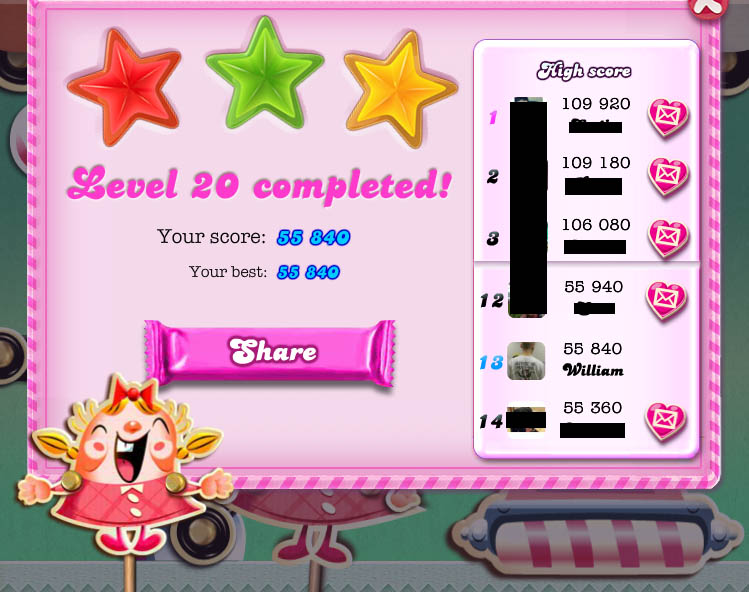 Fig. 3 First prompt to share in Candy Crush
Fig. 3 First prompt to share in Candy Crush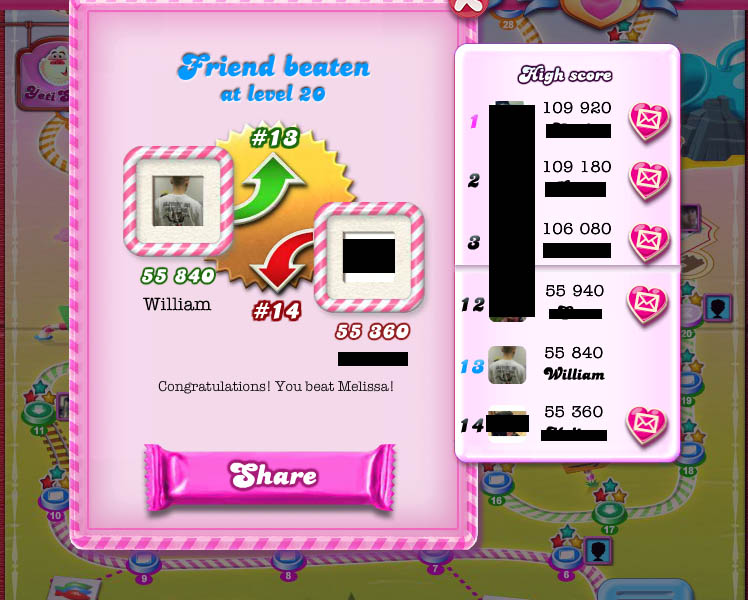 Fig. 4 Second prompt to share (immediately after the first)
Fig. 4 Second prompt to share (immediately after the first)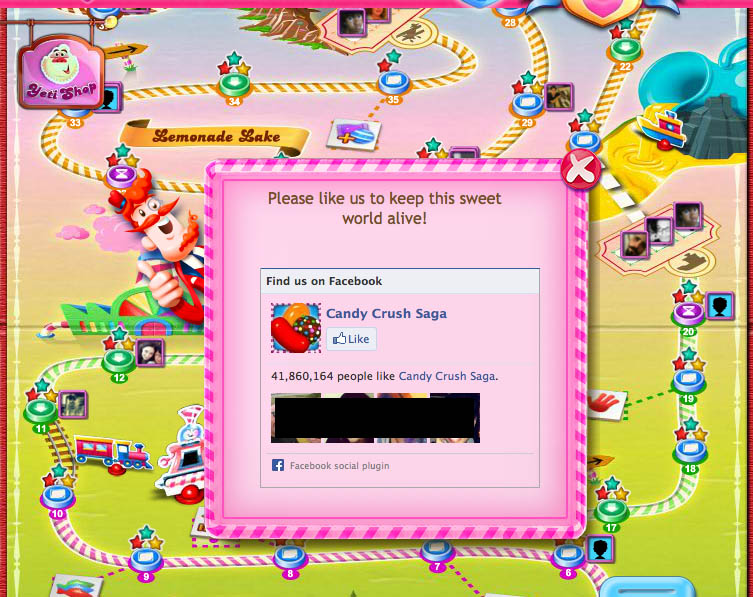 Fig. 5 And, just in case you didn't click the first two times.
Fig. 5 And, just in case you didn't click the first two times.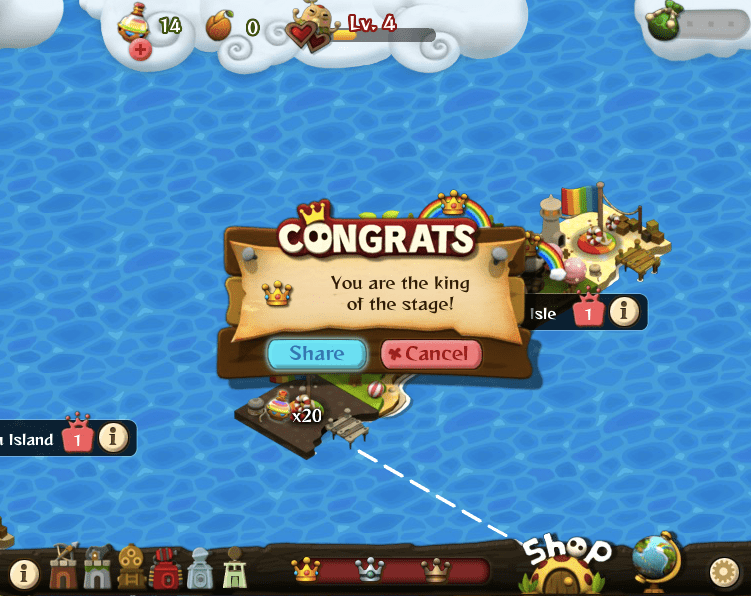 Fig. 6 PixelJunk Monster's single page to share- all in the game-world's style.PMJO opts to keeps the game-world and real world more separate, and I think this does a lot to make the game feel more engaging and special.RULES & GOALSMany free-to-play games include forced waiting time that can be skipped if you are willing to pay real world money (when you run out of lives, for example). This often feels arbitrary and irritating (and was parodied by the "game" Cow Clicker), but in PMJO waiting time is framed in a way that works with the game-world and actually makes the game more fun to play.When you travel to another island, you have to wait 2-5 hours for "your ship to arrive" in the next port. I found it enjoyable to choose my next destination, do something else for awhile, then come back later when my ship had arrived and enjoy the new island. It builds excitement and a sense of travel while also giving you a healthy break from the game.Compare this to Candy Crush Saga, where the player has to wait 25 minutes to get a new life whenever they run out. 25 minutes is just short enough where you feel like you can wait it out, but just long enough to be frustrating and make you feel like you're wasting time.
Fig. 6 PixelJunk Monster's single page to share- all in the game-world's style.PMJO opts to keeps the game-world and real world more separate, and I think this does a lot to make the game feel more engaging and special.RULES & GOALSMany free-to-play games include forced waiting time that can be skipped if you are willing to pay real world money (when you run out of lives, for example). This often feels arbitrary and irritating (and was parodied by the "game" Cow Clicker), but in PMJO waiting time is framed in a way that works with the game-world and actually makes the game more fun to play.When you travel to another island, you have to wait 2-5 hours for "your ship to arrive" in the next port. I found it enjoyable to choose my next destination, do something else for awhile, then come back later when my ship had arrived and enjoy the new island. It builds excitement and a sense of travel while also giving you a healthy break from the game.Compare this to Candy Crush Saga, where the player has to wait 25 minutes to get a new life whenever they run out. 25 minutes is just short enough where you feel like you can wait it out, but just long enough to be frustrating and make you feel like you're wasting time.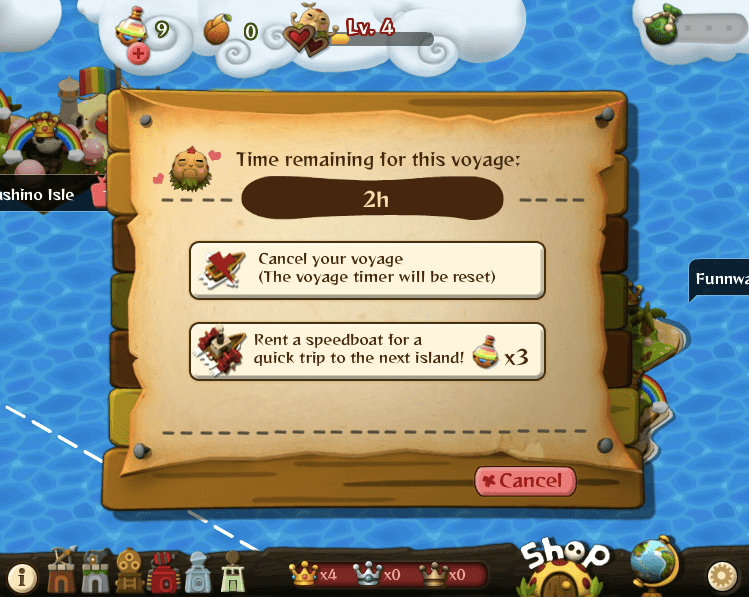 Fig. 7 Traveling by ship takes real-world timeAlso, within each stage of PMJO, the ten "Tiki children" gathered at your home-base act as lives; if an enemy makes it all the way there, one of them dies, and if they all die it's game over. If you complete the stage with some children remaining, they give you "hearts," which act as experience and increase your level. The use of the children in these ways adds to the sense of stewardship over an adorable world and its inhabitants.
Fig. 7 Traveling by ship takes real-world timeAlso, within each stage of PMJO, the ten "Tiki children" gathered at your home-base act as lives; if an enemy makes it all the way there, one of them dies, and if they all die it's game over. If you complete the stage with some children remaining, they give you "hearts," which act as experience and increase your level. The use of the children in these ways adds to the sense of stewardship over an adorable world and its inhabitants.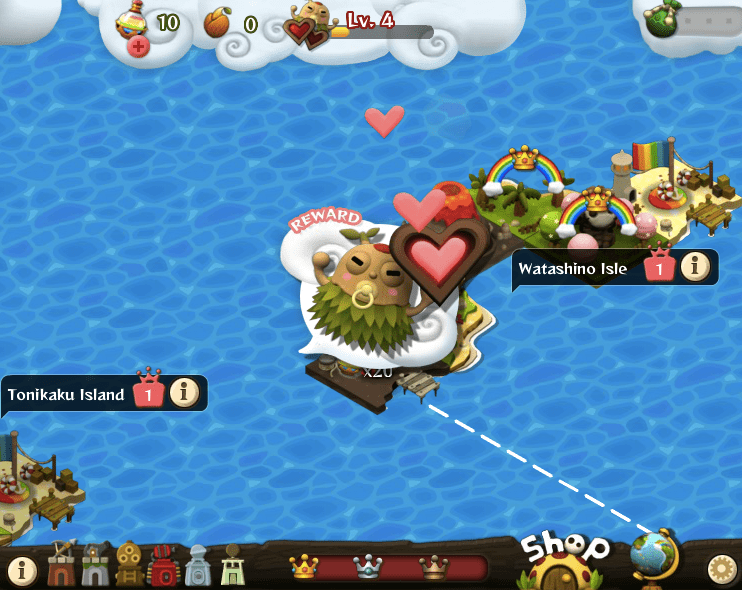 Fig. 8 Your children give you hearts as a rewardTEXTEvery now and then on the main map, a Tiki child at the top of the screen proclaims "I have something to say!"- a cute and unobtrusive way to prompt players to share that also adds to the feeling of stewardship over adorable subjects. The messages that the player is prompted to share are commentary by the characters about the game-world, and usually amusing.Having the highest score in a stage makes you its "King," using the competitive element of social games to the benefit of the worldview. It made me want to perform better than my friends and be the top-ranking King of each stage's Tiki children.SOUNDThe music for the main menu and loading screens is playful and soothing, effectively setting the mood for the game. Dying enemy noises are cute, though a little heavy on high-pitched squealing. Other sound effects are standard and suitable.CONTROLSThe game was difficult to play on a track pad (what game isn't?), and I'm sure it would be easier with a mouse. It is mostly standard "click to move and interact," but I thought the circular sub-menus used to interact with trees and towers were a nice touch.WHAT COULD BE BETTERPersonally, I didn't find the Tiki children to be especially appealing. Something about their pacifiers and quick, barely animated jumping motions didn't charm me- but I felt bad nonetheless when they died.And, though the overworld map is stylistically excellent, some elements in each stage don't fit with the "Tiki island" theme. The towers themselves, made of brick and attacking with crossbows and cannonballs, feel too medieval. The electric shock towers and magma towers are even more out of place, looking like science fiction or even modern military constructions. If the home-base is made out of sand/clay and the small rowboat on the main map is wooden, why are the towers made of brick and metal?
Fig. 8 Your children give you hearts as a rewardTEXTEvery now and then on the main map, a Tiki child at the top of the screen proclaims "I have something to say!"- a cute and unobtrusive way to prompt players to share that also adds to the feeling of stewardship over adorable subjects. The messages that the player is prompted to share are commentary by the characters about the game-world, and usually amusing.Having the highest score in a stage makes you its "King," using the competitive element of social games to the benefit of the worldview. It made me want to perform better than my friends and be the top-ranking King of each stage's Tiki children.SOUNDThe music for the main menu and loading screens is playful and soothing, effectively setting the mood for the game. Dying enemy noises are cute, though a little heavy on high-pitched squealing. Other sound effects are standard and suitable.CONTROLSThe game was difficult to play on a track pad (what game isn't?), and I'm sure it would be easier with a mouse. It is mostly standard "click to move and interact," but I thought the circular sub-menus used to interact with trees and towers were a nice touch.WHAT COULD BE BETTERPersonally, I didn't find the Tiki children to be especially appealing. Something about their pacifiers and quick, barely animated jumping motions didn't charm me- but I felt bad nonetheless when they died.And, though the overworld map is stylistically excellent, some elements in each stage don't fit with the "Tiki island" theme. The towers themselves, made of brick and attacking with crossbows and cannonballs, feel too medieval. The electric shock towers and magma towers are even more out of place, looking like science fiction or even modern military constructions. If the home-base is made out of sand/clay and the small rowboat on the main map is wooden, why are the towers made of brick and metal? Fig. 9 The magma cannon (red) has a modern, military design.The problem is not a matter of the level of technology being realistic for island life- it's a matter of thematic consistency. Since the towers can only be built where a tree is growing, I think it would be more interesting to see the various towers constructed from wood, attacking with items and abilities that suit the Tiki world- an island creature that spouts fire, perhaps, or a hand-made catapult. A little more consistency between the towers and the rest of the game-world would not only suit the game better, but also help set it apart from other games where medieval worlds of castles are extremely common.Similarly, explosions upon enemy death felt out of place and didn't match the game's visual style. PMJO's graphics are an endearing and cartoony "2D-looking" 3D, whereas the explosions look more like a 3D movie effect. Perhaps crumbling to dust might've worked better, or exploding in a juicy "splattered bug" way for the spiders.Finally, the game features coins in each stage that are gathered from defeated enemies and used to build towers. Unlike Rainbow Juice, they cannot be bought with real money, but in many games gold coins are the stand-in for real world money, and for me they carry a lot of the unpleasant connotations of free-to-play money-grabbing, in addition to being overdone and a bit generic.If the idea is that the coins are money and you are "buying" the towers, why not use something like shells or beads? If the idea is that you are using them to construct the towers, why not pots or pieces of clay (with the towers' being made of clay and wood)? Or, if they are just supposed to be pretty and shiny, what about something fun like magical stars? Any of these would give more of a unique touch to the game-world that is lacking with the standard gold coins.SUMMARYVisuals: PMJO creates a colorful, cute archipelago that can be brought to lush life through your journey.Rules & Goals: PMJO uses free-to-play conventions in an unobtrusive and engaging way that works with the game-world and made me actually want to share it with friends.Text: Keeps messages and pop-up windows in the game-world, with little facebook-y intrusion.Sound: Soothing and cute, though the single in-stage song can grow repetitive.Controls: Standard and effective (but playing on a trackpad is not recommended).PixelJunk Monsters Online uses free-to-play conventions such as forced waiting time, sharing, and in-game currency to the benefit of the game-world. A few issues aside, PJMO makes you feel like the king of its endearing world, and you may find yourself wanting to pay money to protect it.
Fig. 9 The magma cannon (red) has a modern, military design.The problem is not a matter of the level of technology being realistic for island life- it's a matter of thematic consistency. Since the towers can only be built where a tree is growing, I think it would be more interesting to see the various towers constructed from wood, attacking with items and abilities that suit the Tiki world- an island creature that spouts fire, perhaps, or a hand-made catapult. A little more consistency between the towers and the rest of the game-world would not only suit the game better, but also help set it apart from other games where medieval worlds of castles are extremely common.Similarly, explosions upon enemy death felt out of place and didn't match the game's visual style. PMJO's graphics are an endearing and cartoony "2D-looking" 3D, whereas the explosions look more like a 3D movie effect. Perhaps crumbling to dust might've worked better, or exploding in a juicy "splattered bug" way for the spiders.Finally, the game features coins in each stage that are gathered from defeated enemies and used to build towers. Unlike Rainbow Juice, they cannot be bought with real money, but in many games gold coins are the stand-in for real world money, and for me they carry a lot of the unpleasant connotations of free-to-play money-grabbing, in addition to being overdone and a bit generic.If the idea is that the coins are money and you are "buying" the towers, why not use something like shells or beads? If the idea is that you are using them to construct the towers, why not pots or pieces of clay (with the towers' being made of clay and wood)? Or, if they are just supposed to be pretty and shiny, what about something fun like magical stars? Any of these would give more of a unique touch to the game-world that is lacking with the standard gold coins.SUMMARYVisuals: PMJO creates a colorful, cute archipelago that can be brought to lush life through your journey.Rules & Goals: PMJO uses free-to-play conventions in an unobtrusive and engaging way that works with the game-world and made me actually want to share it with friends.Text: Keeps messages and pop-up windows in the game-world, with little facebook-y intrusion.Sound: Soothing and cute, though the single in-stage song can grow repetitive.Controls: Standard and effective (but playing on a trackpad is not recommended).PixelJunk Monsters Online uses free-to-play conventions such as forced waiting time, sharing, and in-game currency to the benefit of the game-world. A few issues aside, PJMO makes you feel like the king of its endearing world, and you may find yourself wanting to pay money to protect it.








